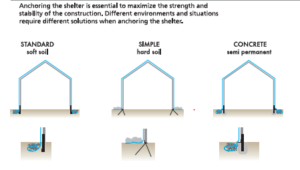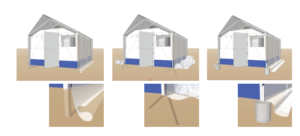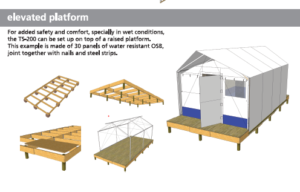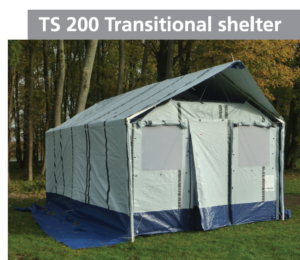Shelter Centre supports
What is the Humanitarian Library?
The Humanitarian Library is designed as a global clearinghouse for regional humanitarian knowledge. As a user-oriented resource, it is designed to be the first reference for both sharing and searching for field-relevant documents. This library was developed by Shelter Centre with funding from USAID/OFDA; the Humanitarian Library is currently supported by project funding through UNOPS. The development builds upon the earlier sectorial ‘Shelter Library’ funded by DFID.
Consensus case study: Transitional Shelter
Transitional Shelter is an approach for those affected to build a minimum safe shelter from local materials, using local skills, tools and techniques. It was developed by Shelter Centre following the Indian Ocean Tsunami, whilst on secondment from DFID to UNHCR.
Shelter Centre later developed guidance on Transitional Shelter with IOM. It is an incremental process which supports the shelter of families affected by conflicts and disasters, as they seek to maintain alternative options for their recovery.
More about Shelter Centre's work with Transitional Shelter
When Transitional Shelters are appropriate, they are normally used for only a small proportion of those affected, as other forms of shelter and settlement are often combined, to reflect the differing needs of the community.
Through its five characteristics, Transitional Shelters can be:
(1) upgraded into part of a permanent house;
(2) reused for another purpose;
(3) relocated from a temporary site to a permanent location;
(4) resold, to generate income to aid with recovery; and
(5) recycled for reconstruction.
Transitional Shelter should only be used as part of an integrated response, combining the agreed transitional settlement options.
 The Global Shelter Cluster compiles case studies about Transitional Shelter in a biannual publication titled Shelter Projects. While the Shelter Projects series is an initiative led by the GSC, many implementing organisations contribute to the case studies.
The Global Shelter Cluster compiles case studies about Transitional Shelter in a biannual publication titled Shelter Projects. While the Shelter Projects series is an initiative led by the GSC, many implementing organisations contribute to the case studies.
More about Shelter Centre's work with Transitional Tents
The process of developing Transitional Tents began in 2000, building upon earlier work with Oxfam GB and MSF, initially as a collaboration with the Cambridge University departments of architecture and engineering. The collaboration resulted in incremental primary research into social and structural topics, informed closely by a consortium of humanitarian agencies and a secondary independent consortium of manufacturers.
The Transitional Tent project was part of a programme supported by DFID to progress a series of priorities identified by the global shelter sector.
Shelter Meeting participants agreed to a five-phased project to produce sector-wide standards, and to inform the development of tents by the global shelter sector.
A number of prototypes have been developed and tested. Manufacturers included Evenproducts, Formens Hus (later Better Shelter, supported by IKEA), Homestil, Losberger, Sheikh Noor-ud-Din and sons, and World Shelter.

 © Better Shelter. “Better Shelter provide refugees with a home away from home on their journey towards safety. Kara Tepe, Lesvos, March 2016.” Shelter Centre worked with Better Shelter, formerly the Formens Hus Foundation, as part of a manufacturer’s consortium for the Shelter Standards project.
© Better Shelter. “Better Shelter provide refugees with a home away from home on their journey towards safety. Kara Tepe, Lesvos, March 2016.” Shelter Centre worked with Better Shelter, formerly the Formens Hus Foundation, as part of a manufacturer’s consortium for the Shelter Standards project.
More about Shelter Centre's Transitional Tent project with the Formens Hus Foundation
Johan Karlsson, formerly Project Manager for the shelter project at the Formens Hus Foundation, participated in Shelter Centre’s consortium on Transitional Tents. Johan is now Managing Director of Better Shelter RHU AB (“Better Shelter”), a social enterprise which is a spin off from the Formens Hus Foundation´s shelter project. Better Shelter works in partnership with the IKEA Foundation and a number of private enterprises and collaborates with the UNHCR in the development of a future shelter specifications.
Johan’s thoughts on working with Shelter Centre on developing Transitional Tents:
“Formens Hus Foundation (the entity which lay the foundation for what today is known as “Better Shelter”) participated in the shelter manufacturers consortium for the Shelter Standards and Shelter Module projects, contributing throughout through comments and meetings over two years. The approach of Formens Hus Foundation to shelter changed radically over this period, informed by the project and discussions with Shelter Centre and the consortium of humanitarian agencies for the project.
The final shelter produced by Formens Hus Foundation was intended as to be consistent with the Shelter Standards finally agreed by both consortia. Formens Hus Foundation has subsequently had positive discussions with humanitarian agencies including UNHCR and future developments are imminent. Formens Hus Foundation valued greatly this innovative and productive new approach to supporting technical development between the private sector and humanitarian sector. Shelter Centre listened to the priorities and motivations of both sectors and as a result, we developed together a transparent and consensus-based approach.
Without a forum and intermediary such as the Shelter Centre, it would have been very difficult, if not impossible, to successfully engage private sector partners in meaningful humanitarian R&D. Shelter Centre was, and remain, one of very few institutions where information on shelter requirements was made available, developed and updated.
The knowledge provided by Shelter Centre services and knowledge library (the Shelter Library, the Transitional Shelter Standards and Guidelines) facilitated a “fast-track” design process which enabled the Formens Hus Foundation to in less than two year to go from a project blueprint into the commercialisation of a new shelter and a new spin-off venture. This process would not have been possible within the given timeframe and budget if these resources would not have been available.
We see an essential need of an entity such as the Shelter Centre to create, collect and distribute knowledge in humanitarian r&d and policy – and would like to underscore the need of more long-term initiatives that can ensure that knowledge can be sustained and developed over time . We hope that further projects will be supported and that Shelter Centre would be able to take on a more long-term and even more extended role as an R&D centre actively co-working with the academic, humanitarian and private sector.”
Consensus case study: Transitional Tents
Tents are normally used only when local shelter options, including Transitional Shelter, are not possible, often due to constraints in time, capacity and materials. While they are light and can be airlifted within hours, tents lack the durability necessary for the average displacement period. The concept of Transitional Tents was introduced to fill this gap by providing a more durable tent suitable for stockpiling and airlifting quickly following disaster impact.
Transitional Tents are intended to last the duration of displacement. They are a minimum safe shelter that can be stockpiled and airlifted, but that can subsequently be upgraded using local materials, skills, tools and techniques, and that can be reused, relocated, resold, or recycled. They are therefore mainly distinguished by their ability to be stockpiled and airlifted.
Peer-reviewed guidance
Through peer-reviewing policy and technical guidance, opinions and experience are reflected and future work supported, improving the quality and effectiveness of communication in humanitarian response.
Whereas in the past, guidance has been developed by single agencies, in the shelter and settlements sector we have developed guidance between agencies by using this collaborative approach.
Below is a list of peer-reviewed guidance dating from 2005, that Shelter Centre or its staff have developed or contributed to. All documents can be found on the Humanitarian Library.









